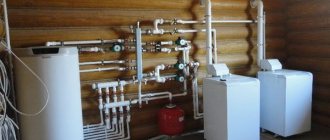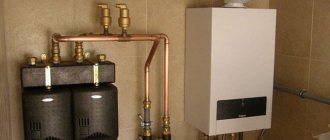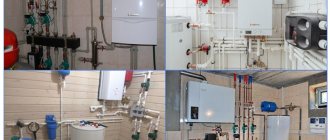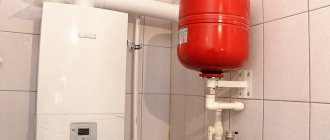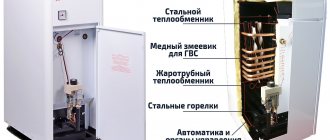Home / Gas boilers
Back
Published: 03/16/2020
Reading time: 6 min
0
10505
The Italian brand Baxi is very popular on the Russian air conditioning equipment market. Gas boilers of this brand are available in several installation options: wall-mounted and floor-mounted, as well as single-circuit for heating and double-circuit for hot water supply.
The manufacturer’s specialists made sure that the installation and operation processes were as simple as possible and accessible to any user. Therefore, to connect the Baxi boiler to operation, the owner does not need to make significant efforts.
- 1 Advantages of Baxi boilers and equipment
- 2 Piping diagrams for Baxi heating systems 2.1 Two-pipe scheme
- 2.2 Single-pipe scheme
- 2.3 Combined diagram of the Baxi gas heating system
- 5.1 System clogging and cleaning
Device and main elements
In terms of their design, TM Baksi units are not much different from other gas boilers. They consist of several components.
Gas burner device
This node includes several elements:
- Gas burner: in the most affordable models, a burner with constant power is installed, in more expensive ones - with step control. To maintain a constant temperature in the room, the automation system has to periodically extinguish such burners and then re-ignite them. The most expensive Baksi boilers are equipped with modulating burners, the power of which is smoothly regulated. Such burners operate constantly and in the most optimal mode, so the set temperature is maintained with high accuracy.
- Combined gas valve: allows or blocks the gas supply to the burner depending on the signals from the automation devices.
- Ignition unit: consists of an electronic circuit and an electrode. This unit converts the mains voltage supplied to it into high-voltage high-frequency pulses, which are supplied to the electrode. As a result, a spark flashes between the electrode and the burner (in some models, between two electrodes), igniting the gas-air mixture on the burner.
The combustion chamber of TM Baksi boilers is closed, that is, air is taken into it from the street. The only exception is the Luna-3 Comfort 240i model, which has an open camera.
The pipe for connecting the gas supply line is located in the middle between the pipes for connecting the heating system.
Heat exchanger
The latter are more efficient due to their high thermal conductivity.
The successful design of the heat exchanger allows you to absorb 90.8% of the heat generated in the combustion chamber (some models have a slightly lower efficiency - 88.7%).
In addition to the main heat exchanger, the Baksi heater may have another one designed for preparing hot water. Such boilers are called double-circuit boilers. Some models, for example, Baxi Ecofor 24, can heat water in an external boiler.
A mesh filter is installed at the inlet of the heat exchanger.
Automation system
All units of this brand use energy-dependent automation. The total power consumption of the boiler, depending on the model, is 135 or 165 W. For most models, for example, Luna-3, Eco-3, Slim, Nuvola, the automation is weather-sensitive.
This means that in addition to the timer and room thermostat, you can connect an outdoor temperature sensor to it. Taking into account weather conditions allows the system to promptly switch the boiler to the optimal mode, which makes the heating system more economical.
The wall-mounted model Luna-3 Comfort (3rd generation boiler) uses a temperature sensor instead of a room thermostat.
Internals of the Luna boiler
Analyzing the information received from it and from the street temperature sensor, this boiler itself calculates the dependence of the coolant temperature on the air temperature outside. This property is called self-adaptation.
Heating unit wiring diagrams
A wall-mounted gas boiler with a closed combustion chamber (turbocharged) is connected to 3 utility networks of a country house/apartment:
Atmospheric heat generators (open chamber), which take combustion air from the room, are connected to a traditional chimney. If you need to use a single-circuit unit for preparing domestic water (DHW), add 1 more connection - to the indirect heating boiler.
First, let's consider the option of connecting the boiler to a radiator heating system or heated floors. For piping you will need the following pipeline fittings:
Addition. If the amount of coolant in the system exceeds 70 liters, an additional expansion tank will be required. To install the tank, purchase 2 more ball valves - shut-off and drain.
We wire the wall-mounted boiler according to the standard diagram presented below. We screw the taps to the fittings of the device with the American side facing down, then we connect the pipes. We place the dirt trap on the heating return, in front of it there is a tap that allows you to clean the filter mesh without emptying the system. It will also allow you to remove the entire boiler in case of major repairs or replacement.
Connection to an indirect heating boiler
Many manufacturers supply wall-mounted gas heaters with connections for connecting the boiler. There will be no difficulties here: we buy 2 ½” ball valves with American ones and connect the water heater heat exchanger. You will also need an overhead thermostat with a temperature sensor installed in a special boiler sleeve. From it we lay an electrical cable to the corresponding terminals of the boiler.
When there are no fittings for an indirect water heater, we purchase a three-way valve with an electric drive. We connect the wall-mounted unit to the boiler according to the following diagram:
How does this scheme work:
An important nuance. When the DHW tank is heated, the boiler automatically turns on at full power, so loading the boiler takes 15–30 minutes, depending on the volume. Returning to heating mode, the unit reduces output according to your settings.
How to connect 2 boilers - wall-mounted gas and solid fuel
In this case, a parallel connection method is used. The problem is different - how to coordinate the operation of heat generators so that they start and turn off automatically. We offer a standard circuit with 2 check valves, a thermostat and a room temperature controller.
How it works:
In a similar way, you can connect 2 other wall heaters - electric and gas. If you need to connect an indirect boiler, radiators and heated floors to two heat sources, we recommend using the diagram of primary-secondary rings shown in the picture.
The diagram shows a wall-mounted electric heat generator; instead, a gas heat generator is connected in the same way
Electrical connection
A wall-mounted water heating device is a mini-boiler room with its own electronic control unit, circulation pump and safety group. The boiler cannot simply be plugged into the first outlet you come across; you must lay a separate cable power supply line, protected by a two-pole circuit breaker, as shown in the diagram.
Recommendations for installation and connection:
Advice. Some wall-mounted imported boilers may be capricious due to incorrect phase location. If after switching on the unit does not want to start, try swapping the neutral and phase wires.
Operating principle
The operation of the boiler is to heat the coolant entering the primary heat exchanger using a circulation pump. At the outlet, the hot heating agent passes through a three-way valve, where it is mixed in a given proportion with a colder return flow, as a result of which the temperature of the coolant acquires the desired value and is sent to the heating system.
Hot water is heated in a secondary indirect heat exchanger. The heat source for it is the hot heating agent, which has not yet entered the three-way valve.
The operation of all components is constantly monitored by a system of sensors that transmit a signal to the control board.
When changing the nominal mode, the display shows an error code related to a specific unit or part of the boiler.
Clogged systems
Dirt and deposits in the heating system can appear not only from the water supply (you need to install mesh filters there) or from the decomposition of antifreeze. Even when installing new elements and starting the system without flushing, the filters can become clogged: in the production of many elements of the heating system, various technological lubricants, powders, etc. are used. And their number can only increase during installation. Therefore, before powering the system and connecting it to the boiler, you need to flush it.
A similar procedure (flushing) should be carried out periodically - when replacing antifreeze or simply for preventive purposes.
Principle of operation
A control board is installed inside the boiler, which controls all the actions of the unit components. It has special contacts, which by default are connected by a special jumper. They are used to connect the thermostat.
While the jumper is in place, the operation of the system is subject to its own logic - the coolant temperature is set, the boiler heats the heating agent to the specified parameters and turns off when they are reached until the water cools down to the lower limit.
When connecting the thermostat, the jumper is removed. The device turns out to be connected to the gap, so all control of the boiler operation passes to it. The work process becomes smoother, frequent starts and stops of heating stop. The air temperature changes more smoothly.
This method of control gives a more successful effect, allowing you to reduce gas consumption and seriously save on heating.
There are many design options for room thermostats. For Baxi boilers, it is possible to use any of them, which is very convenient for users.
All types of thermostats can be divided according to individual characteristics:
Installation location
According to the installation location, all thermostats can be divided into indoor and outdoor (external). The first ones are mounted indoors, the second ones are placed outside and monitor the state of external weather and temperature conditions.
Most owners prefer to control the internal conditions of the premises, since they have a greater impact on the microclimate of the home. External devices are suitable for residents of southern regions, where the thermal insulation of walls is not so effective.
Comfort Series
The Comfort series is a more advanced version of the basic Baxi Luna 3 series, which has expanded functionality.
There are no fundamental differences between the two lines, otherwise the manufacturer would have separated them into different series and given them their own names. There are more models available and new system management capabilities are provided.
Unlike the basic models, the Comfort series is equipped with a remote control panel, which can be used in a wireless design. In parallel with the general functions, the panel is a room temperature sensor, showing the owner the current microclimate indicators in the premises.
Remote control significantly changes the principle of setting and regulating the operating modes of the system, allowing the owner to make the necessary changes from any convenient point in the house, without going to the boiler itself.
Malfunctions and error codes of the Baxi gas boiler
The microprocessor control and monitoring system of a modern gas boiler detects a malfunction and displays an error code indicating a particular malfunction in the operation of the boiler components and assemblies.
Error code on the display of the BAXI gas boiler. The display backlight flashes synchronously with the displayed fault code.
The boiler control system reacts differently to the occurrence of a malfunction. Depending on the possible consequences of the malfunction:
- The operation of the boiler is immediately blocked in an emergency. The boiler turns off. Error codes: E01, E02, E04, E07, E25, E27, E40, E41, E42, E43, E50, E62, E65. It is necessary to eliminate the malfunction and restart the boiler using the “R” button (keep pressed for at least 2 seconds).
- The boiler operation stops abnormally, but is not blocked. After the problem is resolved, the boiler will automatically continue to operate with the previous user settings.
- There are errors - warnings that do not require immediate intervention, in which the boiler operation does not stop.
Advantages of Baxi boilers and equipment
The BAXI brand belongs to BDR Thermea, a large European manufacturer of household and industrial heat and power equipment.
The units are equipped with auxiliary devices of the same brand: a circulation pump for modifications with forced movement of the coolant, a blower fan in closed fireboxes and a safety group.
They ensure that the unit reaches factory operating parameters and have advantages in layout compared to devices that are assembled with components from different manufacturers.
The main advantages of BAXI boilers:
- high thermal efficiency, efficiency up to 92%;
- wide power range from 14 to 80 kW;
- environmental Safety;
- refers to energy efficient equipment;
- Wide range of settings for thermal conditions and automatic maintenance of specified operating parameters.
The latest modifications are available with a powerful self-diagnosis system, frost protection and antibacterial protection.
Integrated weather-dependent automation provides sanitary living conditions in the house, while guaranteeing low cost of generated thermal energy for heating and hot water needs.
Peculiarities
Baxi Main 24 Fi is a double-circuit boiler capable of simultaneously supplying hot water and heating the coolant for heating systems or underfloor heating.
The numbers 24 indicate the boiler power (24 kW), and the letters Fi indicate the turbocharged combustion chamber. It has a closed design that ensures tightness and cleanliness of the surrounding air. The combustion mode is maintained by a fan supplying air flow to the burner.
The main feature of Baxi Main 24 Fi boilers is a bithermic heat exchanger. Unlike other series, not two separate, but one combined version was used.
It is a design in which another tube is installed inside the tube, having a shape close to a rhombus.
The coolant flows along the outer side, and hot water flows along the inner, rhombic side. The OM flow receives thermal energy from the burner, and the DHW flow from the coolant. This design makes the boiler design simpler, more compact, and simplifies adjustment and configuration.
Main components and principle of operation
The Baxi line of gas boilers includes a number of models that differ in volume, type of installation, and functionality. However, the principle of their operation is generally similar.
The most popular boiler models:
- Baxi Luna (Baxi Luna).
- Baxi Slim (Baxi Slim).
- Baxi Main four (Baxi Main four).
- Baxi Main 24 fi (Baxi Main 24 fi.
- Baxi Nuvola (Baxi Nuvola).
- Baxi EKO four (Baxi Eco for, Baxi Ecofor).
Gas boiler baxi luna-3 1.310 - price and where to buy
Baxi Luna
According to the type of installation, gas boilers are divided into wall-mounted and floor-mounted.
The wall heater is fixed using special brackets in any convenient place, which makes wall-mounted models very popular. Chambers with a closed combustion chamber, for example, Baxi Main 24 fi, have increased efficiency and environmental friendliness in a small size.
The volume of coolant in the heat exchanger depends on the model, in the most powerful it reaches 80 liters. In terms of functionality, models can be single-circuit - for heating, or double-circuit - in addition to the heating system, they also supply the hot water circuit.
They can operate both on natural main gas and on liquefied gas from cylinders, making it possible to install them in non-gasified areas. The boilers are completely volatile and require connection to an alternating voltage network.
Operating principle of gas heating equipment:
- Sensors analyze the temperature in the room, and when the minimum value is reached, they send a signal to turn on the circulation pump.
- The pump turns on, creating a vacuum in the return pipe, and the heated water enters the heating system.
- The microprocessor sends a signal to ignite the burner at low power, it gradually increases, and the coolant is heated to a temperature specified by the user.
- Then the boiler operates in modulation mode - it maintains the temperature within the specified limits, turning on when it drops.
At any of these stages, a malfunction may occur, which the boiler notifies using coded errors.
Possible malfunctions of the Baxi Main for, Baxi Main 24 fi, Baxi Eco for boiler:
- the burner goes out immediately after switching on or during the heating process (error codes e01, e04);
- ignition of the boiler is impossible;
- overheating occurs (error code e02);
- The water pressure in the system drops (error code e10);
- extraneous noise is heard during operation;
- there is popping noise in the combustion chamber;
- the coolant does not heat up to the set temperature;
- One of the sensors fails (different error codes may appear).
The most common causes of certain malfunctions, according to service center specialists, may be:
- improper installation of the heating system;
- errors when connecting the boiler to the electrical network;
- water getting into the circuit board, burner or electrical part of the boiler;
- low quality of network water or other coolant;
- sudden drop in gas pressure;
- The network voltage drops or increases unacceptably.
The resulting malfunctions can be easily eliminated by adjusting the boiler, but sometimes it is necessary to call a specialist to replace boiler parts.
If you are not confident in your skills in setting up gas equipment, it is better to contact a service center. Incorrectly performed repairs can lead to complete failure of the boiler!
Nuances of operation
The boiler is very functional; after the temperature mode is set on the operating display, the device will work automatically, with virtually no human intervention.
During operation, you need to pay attention to the absence of noise and vibration, the sufficient temperature in the supply line, the absence of gas contamination in the room and the operation of the heating radiators.
Baksi boilers have an excellent diagnostic system, which will automatically determine the reasons for the unsatisfactory operation of the boiler and, if necessary, stop it. An error code will be displayed on the display for the user so that he can troubleshoot the problem.
For Baxi boilers that are under warranty, independent repairs are carried out only in the case of visible and easily removable causes.
Possible malfunctions of Baksi boilers:
- the gas burner goes out;
- piezo ignition does not work;
- clapping in the firebox;
- high/low temperature conditions of the coolant;
- high/low coolant pressure;
- high/low gas pressure;
- noisy boiler operation.
System clogging and cleaning
The most common malfunction of a Baksi boiler is a sharp jump in the temperature of the water in the heating circuit at the outlet of the device.
The cause of such a failure is a violation of water circulation in the boiler for the following reasons:
- The filter on the water supply to the device is clogged:
- water leak in the heating circuit;
- heating radiators are clogged;
- the surface of the gas boiler heat exchanger in the heating circuit is clogged with scale.
In the latter case, you will need to clean the heat exchanger. To do this, drain the water from the boiler by opening the drain valve on the unit on the right. If possible, drain the water from the heating circuit.
To clean the internal heat exchanger, use the “Jel” device. First, connect the pipes of this device to the Baksi pipes. Remove the cover on the device and pour cleaning liquid into it. Usually its composition is indicated by the manufacturer in the factory instructions.
Turn on the “Zhel” in the power supply for a couple of hours, switching from time to time the direction of movement of the flushing liquid “forward - backward”. Next, disconnect the device and restore the heat supply circuit.
This cleaning of the boiler unit removes all deposits from the internal heating surface of the Baxi Main boiler, thereby preventing the system from breaking down.
Power Requirements
Installation of a voltage stabilizer is required - automation does not tolerate surges well. In addition, for normal operation of automation, a sinusoid close to ideal is required, which is not always present in our electrical networks. Therefore, instead of a stabilizer (or together with it), it is necessary to install an inverter, the output of which will be a stable frequency of 50 Hz (which our networks also cannot boast of) and a sine wave close to ideal. An on-line power supply can also solve the problem. In this case, you will not only supply the required voltage, but also ensure that the boiler operates for some not very long time during a power outage. Connecting rechargeable batteries to the UPS can make energy dependence even less.
For Baksi boilers, both the shape of the pulses and the stability of the characteristics are important
But that's not all the power requirements. It is also necessary to provide protection against impulse currents - we need SPDs that will protect against sudden changes when turning on powerful equipment in the neighborhood or during a thunderstorm. Although, as experience shows, during a thunderstorm the only thing that can save your boiler is a plug removed from the socket, and even then only with proper grounding - there have been cases when the potential “pierced” the automation through the gas pipe. In order to prevent such a situation, all metal pipelines entering the house must have dielectric inserts.
Network voltage stabilizer
Pressure setting
To increase the pressure, a make-up valve is used, and to release the pressure, a drain valve is used.
The optimal value is considered to be 0.7-1 mBar. Usually Baxi boilers independently maintain the desired value, but sometimes failures occur. If there is a constant drop that does not disappear after the system is recharged, then there is an OM leak somewhere.
This could mean either leaking pipes or radiators, underfloor heating systems or other external elements.
Often the problem occurs due to a faulty bleed valve. An abnormal increase in pressure may be due to a malfunction or open make-up valve or damage to the expansion tank membrane.
Price range
The price range for boilers of all Baxi Luna 3 series is between 50-67 thousand rubles. (Comfort series models can cost up to 80 thousand).
This large gap occurs due to the presence of different models and configuration options. When planning a purchase, you should take into account that to this amount you will have to add several types of costs for the chimney, for additional devices - stabilizer and water filters.
In addition, warranty service is provided only on the basis of a contract, for which you will also have to pay.
NOTE! Important! Most service organizations require that installation and initial startup be performed by service workers. Otherwise, warranty repairs may be denied.
Recommendations for reducing operating costs
If all operational settings are made in accordance with the tabular data given by the manufacturer, then the equipment will consume energy very economically, generating the necessary heat in the volume required by the owners.
To do this you should:
For systems with radiators or thermosiphons, select the temperature of the coolant at the boiler outlet +60ºС. It is worth increasing it only if, during operation of the unit, comfortable heat in the room was not obtained. Adjust temperature conditions in accordance with the manufacturer’s instructions and the purpose of the room. To heat bedrooms and other rarely visited rooms, the heating temperature can be set below average. Do not exceed the temperature background recommended by the manufacturers of the heating devices included in the circuit. Use indoor and outdoor temperature sensors that record temperature increases/decrease. The thermostat connected to them will independently start/stop the boiler as needed. Adjust the temperature of the coolant by the hour using a timer. At night, for example, it can be lowered by 3-5 ºС.
It should be remembered that by increasing the temperature in the room being treated by just 1º, we immediately increase costs by approximately 6%.
In order not to constantly change the coolant temperature settings during the difficult autumn-spring period, it is better to install an outdoor temperature sensor. If you don’t find a suitable model or don’t have the funds to buy the original, you can build a homemade device like this:
from To build an outdoor sensor that reads the outside temperature, you can buy a regular NTC thermistor. The example uses B57861-S-65-18 at 10 kOhm 103 A40 with an error of 1%. The device is installed in a plastic headphone case to protect it from atmospheric agents and is wrapped in foil to prevent heating from the sun. In order to bring the sensor outside, you need to drill a hole in the wall next to the boiler. The thermistor is connected to the boiler using a twisted pair cable. Using the graph presented by the Baksi Corporation, you need to adjust the temperature of the coolant according to the graph displaying its optimal values for different thermometer readings. The sensor is fixed on the outside of the main wall. It is advisable to find a place for it that is not directly illuminated by the sun. On the room side, the hole drilled for the cable is lightly foamed or covered with a plastic plug. Stage 1: Assembling a homemade outdoor sensor. Stage 2: Drilling the wall for output to the outside. Stage 3: Adjusting the coolant according to the outside temperature. Stage 4: Attaching the outdoor temperature sensor.
In case of prolonged absence, it is better to disconnect the boiler from the power supply, but you should not turn off the frost protection system. It is turned off only for the summer period, during which the heating function is abandoned, completely turning off the single-circuit model and switching to the dual-circuit version for the supply of hot water.
In order to save on heating, you should not cover radiators with screens and heavy curtains. They will disrupt normal air circulation and force the boiler to work at full capacity for no apparent reason.
Also, the equipment manufacturer does not recommend micro-ventilation in rooms, keeping the transoms constantly ajar. It is better to open the window wide and ventilate in one gulp than to artificially lower the readings of the room temperature sensor for a long time. It has been proven in practice that it is more economical.
When using the water preparation function, it is better to initially select a temperature that is comfortable for use, without counting on mixing heated and cold water in the mixer. Believe me, thanks to this solution, the thermal energy generated by the generator will not be wasted. In addition, limescale will not settle on the inner walls.
Coolants
Most Baksi boilers can work with antifreeze. An exception is all condensing boilers and units with Main Fore bithermic heat exchangers. But if antifreeze is used incorrectly, problems of the following nature may arise: due to insufficient heat removal (when using overly concentrated antifreeze), constant overheating of the system is observed. As a result of elevated temperatures, the coolant begins to decompose, changes color - it becomes dark brown, and precipitation forms in the system. As a result, heat removal deteriorates, overheating becomes even greater, due to local boiling of the coolant, the coil begins to make noise, tremble and knock, and plaque also forms inside it. It cannot be eliminated, so replacement is required. To prevent a milking situation, only specialized antifreezes developed specifically for heating systems can be poured into the system.
The cast iron heat exchanger is almost completely clogged after six months of using antifreeze and constant overheating
There is one more subtlety when using antifreeze liquids: it is advisable to dilute them only with distilled water (although for the most part they should not be diluted). As a last resort, you can use water with a hardness of no more than 5 mEq/l. The use of harder water often leads to sedimentation, which will affect the efficiency of the system and can lead to overheating and, again, to replacing the heat exchanger.
Similar situations may also arise when mixing antifreeze with different additive chemical bases. In this case, decomposition of the coolant may also begin with precipitation and clogging of the heat exchanger. If you do not know or do not remember what composition is in the system, you need to completely drain it and fill in a new one. Don’t forget about the service life of antifreeze – it is often 2-3 years, after which it needs to be drained. Wash the system and power it again.
You can only mix antifreezes of the same chemical composition. If you don’t remember which one was poured into the system, it is better to completely drain it and fill it with a new one
When using anti-freezing compounds, you must also take into account that their thermal conductivity is 15-20% lower than that of water. Therefore, when designing a system, it is worth using either larger radiators or installing more of them. Due to lower thermal conductivity, heat is also removed from the heat exchanger worse; in order to avoid overheating and all the problems that follow, it is worth installing a more powerful circulation pump. So, when using “antifreeze” at -25oC, the pump should be more powerful in pressure by 50-60%, and in flow – 10-15%.
The thermal conductivity of antifreeze is less than that of water, which is why larger radiators are required to maintain normal room temperatures
When using boilers with a built-in circulation pump, the problem can be solved in two ways: by replacing the standard one with a more powerful one, or by using larger cross-section pipes and radiators with lower resistance when building the system. If the system is already ready and it is not possible to replace anything, you can reduce the boiler power (built-in function).
When using antifreeze, you need to choose larger expansion tanks, since they have a greater expansion coefficient than water. Using an insufficient expansion tank can lead to its failure. When designing a system with an “anti-freeze”, the volume of the expansion barrel is taken to be 15% of the total displacement of the system.
Increased demands when using antifreeze and on the quality of connections: these liquids are more fluid, therefore all connections and welds must be airtight.
Do-it-yourself boiler cleaning
You need to drain the water and turn off the tap on the right. If the situation allows, it is better to get rid of water in the heating system. The Zhel device will help: it cleans the system. We connect the device to the Baxi pipes. Remove the cover of the device and fill in the cleaning liquid. Turn on the Zhel device. We work for several hours: we change the direction of the washing liquid. After two hours of cleaning, turn off the device and turn off the tap. When the liquid goes into the device, remove the hoses. We carry out connecting operations of the boiler and heating system. The described procedure will prolong the operation of the boiler, remove scale, and prevent blockages.
Cleaning the secondary heat exchanger
Again he resorts to the washing device. We perform connection operations, turn on Zhel. Close the gas tap and open the hot water tap. Turn off the cleaning device. The liquid will travel along a short circuit of the system.
Before choosing a model and installing a boiler, it is better to listen to a specialist. Baksi boilers have many advantages, but, like all equipment, they do not last forever, and the durability of the devices is not ideal. We assessed the extent of the breakdowns and described the basic steps required for DIY repairs. We hope that you will not regret your purchase and that your boiler will create a warm atmosphere for a long time. And if breakdowns occur, let them be minor and quickly fixable. It’s good when, with a minimum set of tools and in a short period of time, the trouble is eliminated and a warm atmosphere reigns in the house again.
If you think that you can install and connect a gas boiler yourself, you are mistaken. Even if you carefully study the instructions for the Baxi double-circuit wall-mounted gas boiler and acquire the necessary tools, no one will give you permission to carry out such work
It is important to know that the installation, and especially the connection of gas equipment, should be carried out only by experienced craftsmen who are able to complete everything in compliance with the requirements and rules
Upon completion of all work, the technician will certainly perform the first startup of the Baxi gas boiler, which will allow him to check the quality of the work performed. If everything is in order, the equipment is put into operation. Despite the fact that the installation and connection of gas boilers is carried out by a specialist, you should know how to properly install wall-mounted and floor-standing heating boilers, and also carefully study the structure of the Baxi gas boiler - this will allow you to properly operate the equipment in the future.
Kinds
The company produces equipment with various capabilities.
The assortment includes:
- Floor and wall types.
- Single and double circuit.
- Turbocharged and atmospheric (with closed or open burner).
- Cast iron, copper and stainless steel heat exchangers with different capabilities and efficiency.
This abundance of options allows users to choose the optimal installation to suit the needs of a given room.
IMPORTANT!
Baxi boilers are initially manufactured to operate on natural gas, but at any time they can be converted to liquefied gas, for which you need to change the gas burner nozzles.
Menu for displaying information about the operation of the Baxi boiler
On the display of the Baxi boiler, in the information menu, the designation of the first line A00 alternates with the value of the parameter of this line - 35 ºС.
To display a menu of information about the operation of the boiler on the display located on the front panel of the boiler, press the “i” button for at least 6 seconds.
The “INFO” function is activated and the designation of the first line of the information menu “A00” appears on the display, which is replaced by the display of the temperature parameter.
To move through the lines of the information menu, press the buttons (tap +/-).
BAXI Main Four |Baxi Eco Four | BAXI Four Tech:
Line A00: effective value (ºС) of the domestic hot water temperature (DHW system);
Line A01: value (ºС) of the outside temperature (with an outside temperature sensor connected);
Line A02: Instantaneous value (%) of the gas valve control signal;
Line A03: value (%) of power (MAX R);
Line A04: set value (ºС) of the supply temperature to the heating system;
Line A05: effective value (ºС) of the water supply temperature to the heating system;
Line A06: set value (ºС) of domestic hot water temperature;
Line A07: % flame level value (0 – 100%);
Line A08: current value (l/min x 10) of domestic hot water consumption;
Line A09: the last error detected in the boiler operation.
ASSEMBLY WITHOUT GASKETS
The firebox body consists of three types of parts: the leftmost section (L), the middle sections (M) and the rightmost section (R) (see Fig. 1 and 7).
Screw the studs (with the short side of the thread) into all threaded holes of the cast iron parts (see Fig.
rice. 2).
- Install the exhaust manifold (D) onto the rightmost section using one of the plates (A) (see Figures 3 and 4).
- install the leftmost section in the same way (see Fig. 5).
- Place the outermost section through which the exit is made on the floor in its final place ( in our example, the left section
), and check the alignment of 1 fence in flange “A” (see Fig. 5). The other outer section remains shifted (~20mm) for the convenience of installing the middle sections (see Fig. 4).
- Apply fiberglass sealing strips to the front and rear grooves on one surface of each middle section using the neoprene adhesive supplied with the boiler. The same operation is carried out with the rightmost section (excess tape remains on top) (see Fig. 6).
- install the middle section, resting on the outer section on the outlet side and on the manifold. Repeat this operation for all middle sections (see Fig. 7).
Attention: It is necessary to constantly press the outer section in the direction of the arrow (see fig.
8), when installing the last section, slightly unscrew the plate “A”, press the section and then screw the plate.
Reinstall the three alignment pins (T) and adjust the distance B at the front and rear (see Fig.
table and fig. 13).
Install the rear manifold (E) (see Figure 9). A centering key welded onto the commutator ensures precise alignment of the commutator in relation to the clamping bracket (F). Secure the clamp bracket with two nuts on each end.
